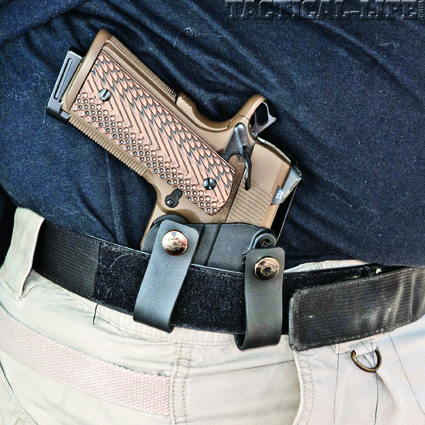Pistols are becoming smaller and more reliable, making them far easier to carry. There are so many choices these days in holsters it almost boggles the mind. Every year a new purse, bag or other device designed to conceal a firearm comes out. These ever-increasing options bring about an ever-increasing complexity when it comes to deploying the weapon—something many simply fail to consider. That’s why we’ve created this list of lifesaving concealed carry tips to help you out.
It becomes incumbent upon the responsible concealed carry holder to ensure they can safely deploy their firearm. To quote Voltaire, “with great power comes great responsibility.” In this case, that responsibility is to properly train yourself to safely remove your firearm under the stress of an actual application.
Concealed Carry Tips Could Keep you Alive
Many would contend there is no greater power than the ability to potentially take life—something a pistol is certainly capable of doing. On the other hand, if properly deployed it can save lives. A recent incident in Salt Lake City is a perfect illustration: While walking through the parking lot of a grocery store, a CCW holder observed a stabbing in progress. The safe and proper deployment of the citizen’s firearm not only stopped the aggression, but also held the suspect in place until officers arrived. That may be as close as you get to the ideal use of a concealed firearm for protection of others. The victims survived, the suspect was arrested, and the concealed carry holder was uninjured. There is certainly no guarantee similar incidents will be the same, but practicing a few things can certainly help.
Advertisement — Continue Reading Below
1: Choose Your Pistol Wisely
Choose a carry pistol that works and can be accessed when necessary. All the convenience in the world is pretty useless if you cannot get to it when you need it. Decide up front whether to carry a pistol for comfort or protection—if you are going to carry a pistol for protection make certain it will actually protect you.
2: Concealment
There is a trade-off here, as you need to be able to access your pistol. The best concealment may not facilitate access. You really need to take some time and figure out where to carry your firearm so it is not visible yet still remains accessible. That is going to take some trial and error, but carrying a firearm for protection is all about compromises and tradeoffs.
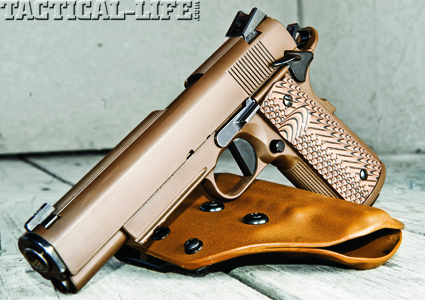
Weigh your options—literally. Even a full-sized 9mm 1911 can be carried effectively. While it may be a bit less comfortable on the hip, it certainly brings substantial firepower.
Advertisement — Continue Reading Below
3: Carrying
It is important to understand the “best” place to carry your firearm for use may not be the most convenient. Carrying your pistol in a bag, purse, or other item off your body is convenient. Having a pistol in your glove box is really convenient, but it is useless unless you are sitting in the car. All of these devices add time and complication to drawing your pistol, both of which lessen its effectiveness in the real world. If you are prepared to use your pistol the best place to carry it is on your person. The best way to carry it on your person is in a high-quality holster.
4: Where To Carry?
For most your strong side hip is the most accessible carry position. It also allows flexibility—something that can be problematic with a pistol in the front of your pants, a shoulder holster or other more convenient spot. It is faster, more secure and safer to remove. If you decide to carry it elsewhere make certain you practice, practice, practice. Either way, carry it in the same place all the time. Time is something you seldom have a ton of in these situations, especially time to “find” where you decided to carry your pistol that day.
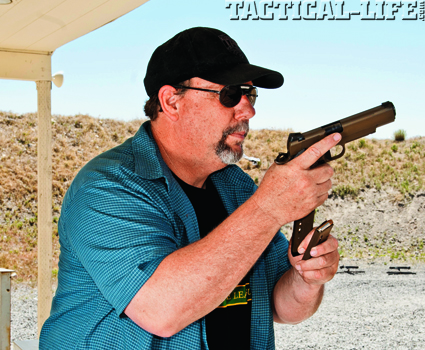
Advertisement — Continue Reading Below
5: In Or Out
Inside or outside the pants is a personal preference. Both present their own issues. Holsters outside the pants make concealment considerably more difficult but provide the best possible access under stress. Inside the waistband conceals well but can be uncomfortable, especially if you have some excess baggage. If you carry an IWB holster make sure your undergarment is tight and does not interfere with the draw or holstering of your firearm. If your gun has a safety, make certain it cannot be deactivated while in the holster.
6: Appropriate Clothing
In order to conceal a firearm on your person it is going to be covered with a shirt, jacket, or other garment. Take some time to choose this garment wisely. Covering a pistol with something that is mesh, or has strings or other items hanging from it can be problematic. It can be difficult to deploy your pistol if your cover garment is hung up on it as you move it out of the way. Keep it simple and smooth. You need to be able to easily sweep it away when necessary. Several companies make excellent shirts designed specifically for this purpose. Oversized T-shirts work well, as does the ever-present sweatshirt. When wearing a jacket put some keys in the strong side pocket; it facilitates it swinging out of the way on the draw.
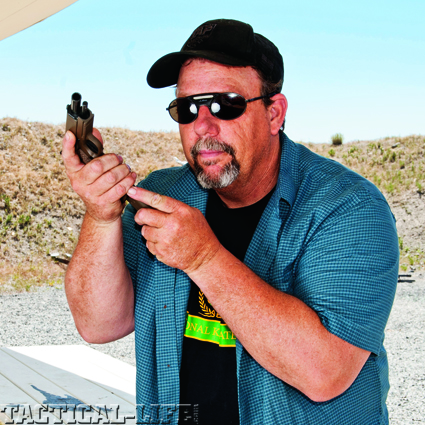
It’s imperative to practice both empty and tactical reloads—remaining certain to keep the pistol positioned so you can still keep your threat within your eyesight.
Advertisement — Continue Reading Below
7: Practice
Practice drawing with your choice in concealment. Just as critically, practice re-holstering, making sure to clear your garment from the holster. It means pulling up your shirt or sweatshirt, and sweeping your jacket or shirt out of the way. Make certain you practice doing so with one hand as the other may be holding a phone. The might be the most important of our concealed carry tips because shooting is a perishable skill.
8: Carry Spare Ammo
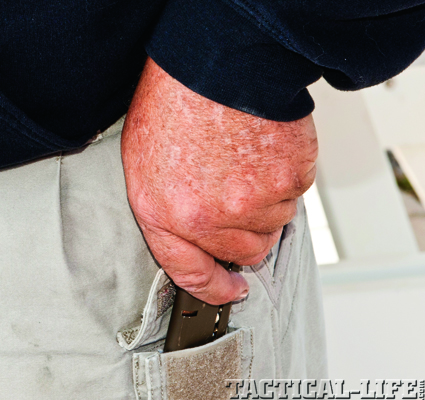
Emergency “bug-out” bags are all the rage these days, but unless you have it with you when the fight happens it is pretty useless. You really need a spare magazine or ammunition on your person. You can carry it in a pouch or a pocket, just make sure you can get at it. It is best carried on the opposite side, facilitating a natural reload.
Advertisement — Continue Reading Below
9: More Practice
Spend some time on the range practicing your reloads from your preferred concealment. It may change where you carry it, but you really need to have it accessible. Lots of dry practice is very helpful, and spend some range time performing both your empty and tactical reloads.
10: The Last of our Concealed Carry Tips
Take the time to put all of this together and practice regularly while maintaining exactly the condition in which you carry. Practice your draws dry from every practical position. Practice in the car, from a seat or even sitting on the ground. Do so with your cover garment in place. Make certain you can safely remove and re-holster the weapon. Practice reloads from different positions. It is all about practicing exactly what you are going to wear and use on a day-to-day basis.
Police officers are encouraged to “practice how you deploy” for a reason—it saves lives. It is just as valid a doctrine for those who carry a concealed firearm. Carrying a firearm brings with it tremendous responsibility. It is imperative you practice in a manner that best prepares you to safely deploy that firearm in the real world. Failing to do so just may cost you your freedom, and possibly your life. Take it seriously, and take the time and effort to be prepared when the time comes to move outside the theoretical and into the real world.
Advertisement — Continue Reading Below
